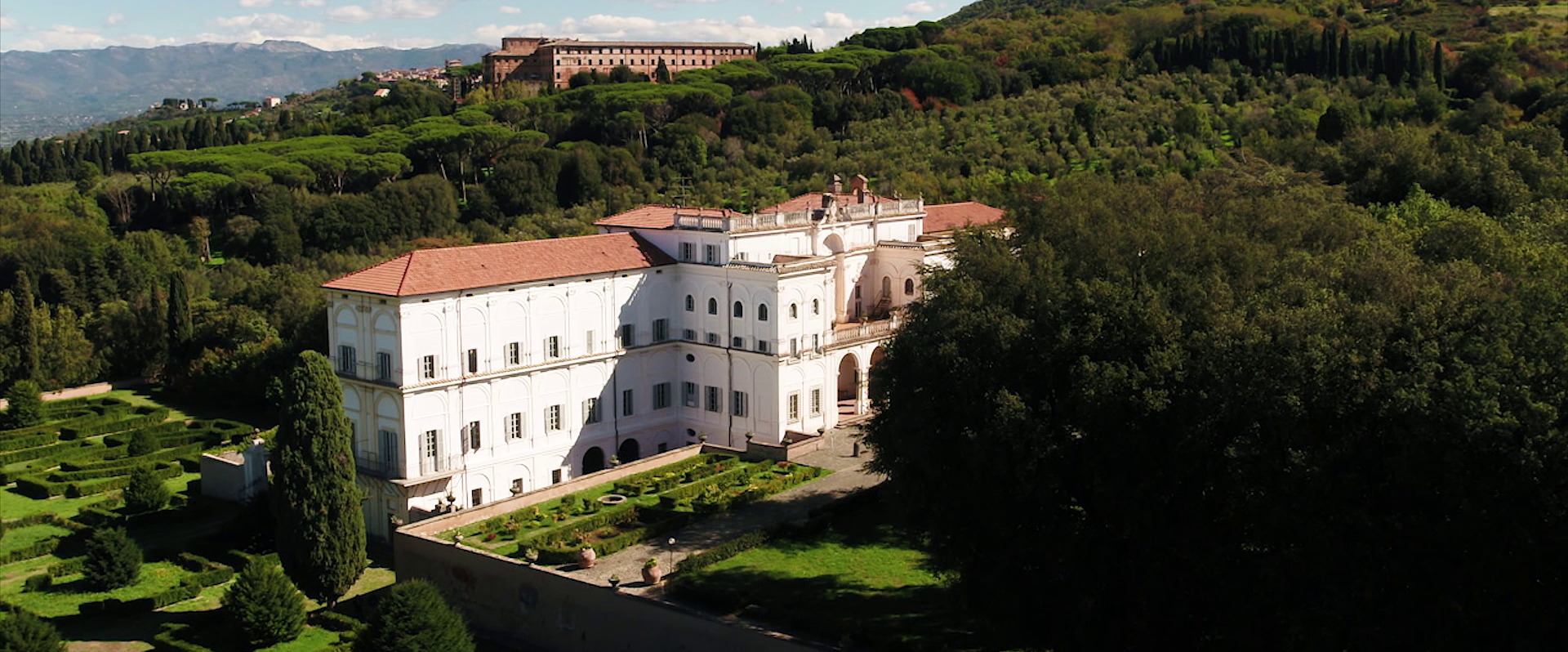Villa Falconieri
Short history
The Villa Falconieri, first among today’s Tusolan villas, was built in the mid 1500s on the site of an ancient Roman villa at the behest of Bishop Alessandro Rufini of Melfi. Pope Paul III Farnese, as a medal that he minted for the restoration of Frascati seems to indicate, enlarged this villa around 1546 under architect Giovanni Lippi, called Nanni di Baccio Bigio, of the circle of Antonio da Sangallo the Younger. From 1573 to 1623 ownership of the villa cycled between the Cenci, Sforza, Gonzaga and, perhaps, Montalto families. These families, the Gonzaga and Sforza families in particular, promoted the development of Humanism and the Renaissance by their patronage of artists and intellectuals.
In 1628 the villa was purchased by the Falconieri family, remaining in their hands until 1879, when the complex was sold to Elisabetta Aldobrandini Lancellotti. The Falconieri family commissioned an architectural extension of the villa from Francesco Borromini, who in the last moments of his tragic life seems to have worked on it together with other projects. The attribution of the villa drawings, if not of the execution, to Borromini is controversial, and recently the designer has been identified as Camillo Arcucci. The frescoes inside are the work of Pier Leone Ghezzi, Giacinto Calandrucci, Ciro Ferri, Nicolò Berrettoni, Francesco Grimaldi and others. Inside can also be found pictorial decorations of the sixteenth century, attributable to Luzio Luzi Roman and Piero Bonaccorsi, also known as Perin del Vaga.
The Falconieri family endowed the villa with a rich library (inventoried in 1849, but built from the 17th century onwards). The family also organized musical events and theatrical performances and hosted the circle of intellectuals that gathered around Queen Christina of Sweden, including Ottavio Falconieri, nephew of Orazio and Cardinal Lelio Falconieri. Beginning in 1656, the Falconieri family granted twenty annual scholarships for young students "capable, needy, and of good behavior,” but also for “noble births, as long as capable," in order that these young men dedicate "work to [their] studies". After hosting, from 1898 to 1905, the Trappist monks of the Abbey of the Three Fountains, who caused quite a few damages to the frescoes, considering them not to be in keeping with a monastic environment, the villa was purchased in 1907 by the German baron Ernest Mendelssohn-Bartholdy, grandson of the composer. Mendelssohn donated the villa to Emperor Wilhelm II, who upon visiting in 1911 decided to use it as the seat of a German school of fine arts and literature (entrusted to the Germanic Institute in Rome) that would compete with the French Academy of the Villa Medici in the capital. In 1911 the emperor financed various improvements to make the stay of the intellectuals who were hosted there every year from April to November more pleasant. By 1907, for example, another building had been built (the current "red house", developed on two floors), to allocate the studios of the artists. Here the German writer Richard Voss lived for many years beginning in 1880, and wrote novels such as Villa Falconieri, Febbre romana, Il figlio della Volsca and others during his time here. The villa was frequented by, among others, the painter Philipp Hackert, the great German historian F. Meinecke and the writer Paul Heyse, who wrote a short story dedicated to the Villa Falconieri.
After the First World War the villa was confiscated by the State. After 1928 the villa was the seat of the budding International Institute of Educational Cinematography directed by Luciano De Feo and hosted, for example, Louis Lumière on 26 March 1929. For a short time beginning in 1938, the villa served as the seat of the National Institute for Foreign Relations (INRE) directed by Galeazzo Ciano. During the Second World War the villa was occupied by the German military command under the orders of Feldmaresciallo Kesserling. Seriously damaged by the bombing of September 8, 1943, which destroyed the entire right wing, the rural house, and the caretaker's house, the villa fell into a period of neglect aggravated by looting. This desolation was interrupted only by the intermittent presence of "heliotherapy colonies" for the children of Frascati. From 1956 to 1958 the villa was restored and underwent major redevelopments in the years between 1983 and 1996. After an aborted attempt to host an academy for Latin American scholars, not unlike the French equivalent at the Villa Medici in Rome, the villa hosted the European Centre for Education (EEC, then CEDE) from 1959 until 1999. From 2000 to 2015 the villa was the seat of the National Institute for the Evaluation of the Education System (INVALSI) and was entrusted to the Vivarium novum in 2016.
Book a visit
The Academy opens its premises to the public every Sunday with guided tours scheduled for 10 a.m. and 12 p.m., with the exception of Sundays on which conferences and other cultural initiatives of various kinds are held.
The guided tour is held in Italian and is free of charge. Reservations are required and can be made by writing directly to the address provided visite@vivariumnovum.net or by filling out the following form (by 4 p.m. each Friday for the following Sunday). A confirmation will be sent by our secretariat. Please check your spam folder if you believe you have not received a reply.
 English
English
 Italiano
Italiano
 Latina
Latina

